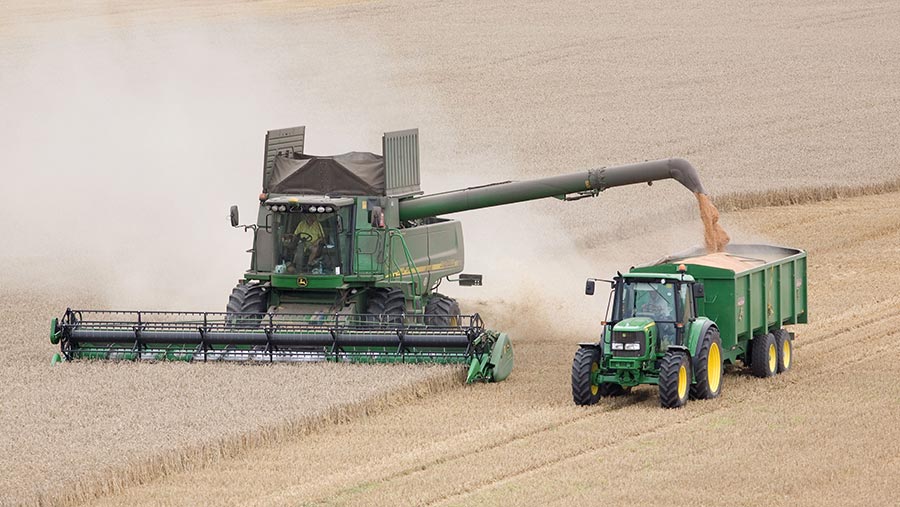High global grain crops and stocks weigh on market
 © Tim Scrivener
© Tim Scrivener As the UK faces up to significantly reduced grain production this year, global influences will continue to shape price prospects for growers, says Cofco UK trading director Stuart Shiells.
While Europe’s wheat production is estimated to be down by 13% in 2020, the world could easily end up with record closing stocks this year.
Covid-19 has had a crippling effect on demand, so global grain supply remains stubbornly high with strong wheat production estimates for Russia, Australia and Canada making up for the EU shortfall.
Add in a potentially record US corn crop and it’s increasingly clear that while the UK might be suffering, the world will not be short of grain as autumn approaches.
See also: Extending year end date could ease cashflow pressures
The situation feels very different to this time last month, when prices spiked following disappointing early yields in southern Russia and fears of hot, dry conditions in the US.
Strong Russian yields
Strong yields in Russia’s Central and Volga regions have since lifted wheat production estimates that hit 76m tonnes in mid-July, to more than 81m tonnes – a sizeable increase on last year’s crop of 73.5m tonnes.
Similarly, July’s concerns for US corn have receded, with more seasonal temperatures and rainfall pushing production estimates towards a record crop.
Although weather in Australia has been mixed, good rainfall in August has taken production estimates to 27m tonnes compared to 15.2m tonnes last year.
Canada is also adding pressure with the potential for a record wheat crop, but it’s a very different picture in Europe.
France’s wheat crop, at 29.5m tonnes, is one of its smallest in the past 25 years.
Dismal wheat harvest
The UK’s dismal wheat harvest is likely to be in the region of 9.5m tonnes compared with 16.2m tonnes last year – a drop of more than 40%.
With the exception of Spain, which has experienced bumper wheat and barley crops, most other EU countries have struggled with below-average yields.
To put all this in context, while the EU’s estimated wheat harvest of 128.1m tonnes is some 19.1m tonnes down on last year, this will be negated by Russia’s and Australia’s increases of 7.5m tonnes and 11.8m tonnes alone.
With such a strong global supply picture and demand still limited by Covid-19, it is very difficult to see how any sustained rally in wheat can gain traction.
UK prices shaped by global events
Harvest has progressed at a good pace to date, but there is no escaping the UK’s disastrous level of production due to the reduced winter area and low yields.
With no pressure on logistics and farmers reluctant to sell, it has never really felt like harvest.
Yields are mixed and below the five-year average, but quality is generally good, albeit with variable protein and nitrogen contents on the high side.
Demand remains a problem, too. Malting barley use, for example, is still heavily down, with maltsters having considerable stocks of old crop following the hospitality industry shutdown.
Barley’s exportable surplus will be a similar size to last season, but, so far, exports have been much slower.
The UK’s usual volume destination of Spain is only taking a few cargoes due to its own strong production, so the majority of UK feed barley is being shipped to the Netherlands and Ireland.
Barley challenges
With the 31 December deadline for leaving the EU looming, barley exports must pick up sharply to avoid potential tariffs, but this will be challenging, with strong competition from a large EU barley crop and cheap corn.
Overall, the biggest driver for UK wheat prices will be imported maize.
Due to strong global production and reduced ethanol demand, maize is very cheap.
While we are already at import parity for wheat, maize – which can be imported tariff-free – will make up a sizable proportion of the UK’s wheat deficit and will heavily influence UK wheat prices.
A summary of the current main price factors and their probable influence
Red: Factors putting downward pressure on prices – accounts for 50% of current market influence
Strong production in key markets and low global demand resulting from coronavirus is allowing global stocks to build.
Amber: Watch this space – 30%
Weather changes in the US could still affect its corn crop, while any hint of weather disrupting Southern hemisphere crops could unsettle markets.
Green: Factors exerting upward pressure on prices – 20%
Chinese buying could create short-term rallies as could the impact of the smaller EU crop with slow farmer selling.
